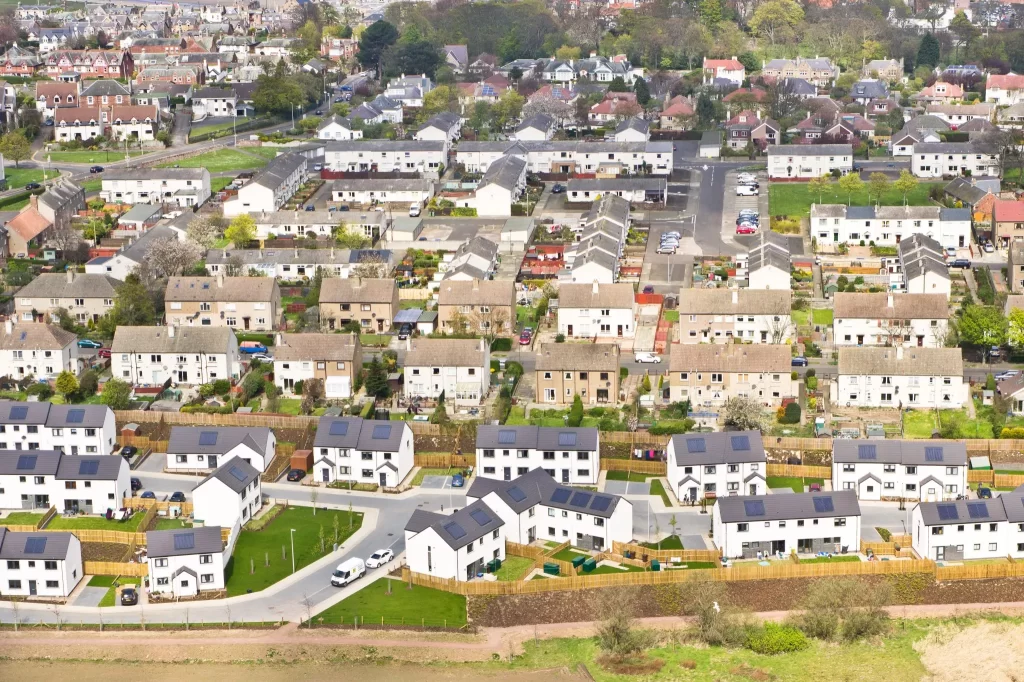There are a number of legislative changes ahead for the UK real estate market, including more defined energy efficiency standards and an overhaul of the building control process.
Some of the principal issues for housebuilders and owners include leasehold reform and possible changes for the English private rented sector.

Minimum Energy Efficiency Standards
From 1 April, it is not just granting a lease of a commercial property that is below the minimum energy rating that puts a landlord in breach of the Energy Efficiency (Private Rented Property) (England and Wales) Regulations 2015; continuing to let a sub-standard property will become unlawful (although it will not invalidate a lease).
To stay within the rules, commercial property must be let with an Energy Performance Certificate rating of E or above, or landlords must register an exemption. Breach can mean financial penalties of up to 20% of the property’s rateable value.
Exemptions can be granted, for example, where the cost of purchasing and installing the equipment required to attain the required rating does not meet the 7 year payback test (Regulation 28(3)).
Preparing for even higher standards
Businesses need to be thinking about their green credentials for the future, not just the impending deadline, but also for longer term. There will be gradual restrictions imposed by the legislative regime: by 2027; the minimum standard is likely to rise to a C; and by 2030, to a B, which is a very demanding task for most occupiers.
Rating values are likely to be affected
Alternative methods of rating properties are possibly on the cards, with requirements for more frequent assessments. Tenants negotiating leases should ensure that they understand whether the terms require them to carry out works to improve environmental standards in consequence of laws passed after the date of their lease. If the task of carrying out necessary environmental upgrades is to fall on the landlord, the landlord will need to reserve appropriate rights of entry to carry out the required works; the tenant will need to consider the likely disruption to its business. Forward planning is essential.
Decarbonisation drivers
Improvements to our built environment will undoubtably be driven by the need to stay legally compliant. The movement in commercial lettings in recent years demonstrates the rising importance for buildings with elevated green labels, assisting occupiers with the implementation of their decarbonisation policies.
Investor landlords also have net zero goals, many of them highly ambitious, driven by investor demand. Constructing buildings to achieve green certifications, such as BREEAM, is gradually becoming more the norm, as developers seek to meet the growing appetite for a sustainable future and understand the increasing importance of these new standards. The carbon footprint of any building is largely determined by the energy required during occupation, and often represents two thirds of the total carbon count. Therefore, the nature and design of the building services (mechanical and electrical) is a fundamental aspect that needs to be at the top of the design agenda.
Decarbonisation goals are also encouraging agreements between some landlords and tenants committed to reducing the environmental impact of their building, particularly with regard to sustainable materials, energy efficient plant, renewables and recycling initiatives. With the increasing ability of new technology to offer powerful insights into the optimisation of energy use in the built environment, parties are increasingly agreeing to collect and share data with a view to collaborating on strategies to reduce their carbon footprint.

Compulsory Auction of Empty High Street shops
Owners of high street retail premises should be aware that Part 8 of the Levelling-up and Regeneration Bill, which is currently at the reading stage in Parliament, is intended to give local authorities the power to conduct compulsory rental auctions of certain vacant high street premises.
The local authority will have the power to do anything the owner could do in order to let the premises, including granting rights over land outside the premises, and any superior landlord and mortgagee will be deemed to have consented, if required.
To satisfy the criteria to be considered for auction, the local authority will need to have allocated the area in which the premises are located to be a “designated high street” or “town centre” due to its importance to the local economy. This will be listed as a local land charge. The premises will need to have been unoccupied for a year or 366 days within the previous two years and the local authority must consider that occupation of the premises for a high-street use would be of benefit to the local economy, society or environment. The local authority will need to give the owner notice and the opportunity to let the premises (on genuine terms) prior to the auction.
While the enabling legislation is anticipated this year, the regulations to implement the detail will require time.

Reduced land disposal burdens for charities – likely spring 2022
Provisions in the Charities Act 2022 relating to the disposal of land by charities are due to come into force in Spring 2023. Ownership of land in England and Wales by charitable organisations is extensive and varied. Some large charities own significant open space; stocks of housing land are owned and let by social landlords registered as charities and charity shops are a familiar feature of the high street.
Regardless of the size of the land holding, any disposals of land held by charities in England and Wales will be impacted by the Act. It will also be of relevance to those acquiring land from charities.
The new provisions are expected to introduce a proportionality into the statutory requirements for charity land disposals. They will entail a softening of the rigid rules that currently relate to pre-disposal advice, allowing charities to instead take less prescriptive advice on land disposals from a larger pool of people with requisite expertise, including suitably qualified people within a charity. It will also remove the obligation for charity trustees to certify in their individual capacity in the document transferring title that the relevant requirements under the Charities Act 2011 have been met.
The key principle remains that charities should take steps to maximise the value of the land of which they dispose. There is now likely to be fewer and easier hoops to jump through to attain that goal.

Building Safety Levy consultation closed on 7 February
On 22 November 2022 the Government launched a further consultation on building safety measures – The Building Safety Levy. This Consultation sought views and evidence from within the sector on the technical details and implementation of the Building Safety Levy (Levy). The Levy, which was announced in February 2021 aims to “ensure that the taxpayer does not pay for the necessary remediation of buildings safety defects. The details for the Building Safety Levy are expected to be finalised this year and the consultation is due to end on October.
Like the Residential Property Developer Tax introduced on 1 April 2022, the levy is intended to raise funds to remediate unsafe defects in buildings. Under the proposals, local authorities will collect the levy from developers of residential buildings (regardless of the building’s height). While affordable homes, care homes and developments of less than 10 units will be exempt, it has not yet been determined whether built-to-rent, purpose-built student accommodation and senior living residences will fall within scope.
Overhauled building safety regime likely to be operative by October
We can expect the publication of building safety regulations throughout 2023 to support the implementation of the more stringent building control regime under the Building Safety Act 2022 which is planned to come into operation late this year. The Act aims to drive an industry culture change with greater accountability and responsibility for fire and structural safety issues throughout the lifecycle of a building.
‘Golden thread of information’
Clear digital records with required design and safety information about high rise residential buildings will need to be maintained: providing easily accessible details relevant for emergency responders, ongoing risk management and to enable any later changes to the building to be sensibly reviewed against the original design intent. This is referred to as the “golden thread of information”. From planning and design to construction, through to occupation and the later responsibility for ongoing repairs, accountable parties are identified and given formal obligations to identify and manage building safety risks.
Gateway regime
The regime also establishes a new Building Safety Regulator to oversee building safety and set building standards. The regulator is also responsible for granting approvals at each stage of a new “hard-stop” Gateway regime which will apply to new developments of high rise residential buildings. Any such development will be unable to proceed to its next stage until it successfully passes the regulatory requirements of each relevant Gateway.
Gateway one (which is already in force) is the early consideration of fire safety at the point of seeking planning permission and Gateways two and three are expected this year. Gateway two provides that no construction can begin until the regulator is satisfied that the designer and the build contractor have delivered statements and plans to comply with the relevant regulatory requirements. Gateway three ensures that the building cannot be occupied until the regulator has certified that the buildings have been correctly constructed and appropriate golden thread information has been supplied to the “Accountable Person” who will be responsible for ongoing repairs and safety of the building. After Gateway three, occupation remains prohibited until an Accountable Person has registered itself and the building with the regulator.
While the golden thread of information and the Gateways are focused on high rise residential buildings (with some aspects including other vulnerable buildings such as care homes and hospitals), the Act will also bring in wider changes to the building regulations to improve design and construction standards for all buildings.

Biodiversity net gain
It is expected that from November 2023, planning permissions for most new developments in England will be subject to a condition that the developer delivers a biodiversity net gain of at least 10%. The enhancements for wildlife must be sustained for at least 30 years after the development has been completed.
This means additional due diligence and planning for developers with careful evaluation of the costs in consultation with the planning authorities to assess project viability and pricing. It is anticipated that purchasing off-site credits may be an option where a developer is unable to manage biodiversity requirements within a particular scheme, but it is likely to take some time before the market in such credits is established and planning authorities may be keen to promote on-site provision in the interests of creating more attractive living conditions for residents.

Infrastructure Levy
The Levelling Up and Regeneration Bill (the Bill) was introduced into the House of Commons on 11 May 2022. The Bill proposes an Infrastructure Levy (IL), which would enable local authorities to impose a “tax” on development used to fund traditional infrastructure such as roads, transport facilities and open spaces, as well as additionally defined infrastructure such as childcare provision and affordable housing.
The new levy is intended to meet the shortfalls of the Community Infrastructure Levy (CIL) which is currently in force in England and Wales, introduced by the Planning Act 2008. The proposals will allow charging authorities to determine contributions according to the local context, measured against the Gross Development Value (GDV) of a completed development.
We may see the start of pilot schemes for the Infrastructure Levy (IL), the intended successor for the trouble-ridden Community Infrastructure Levy, the framework for which is also set out in the Levelling-up and Regeneration Bill. The IL will focus on land value capture (being based on gross development value rather than floor space) and it is envisaged that it will become mandatory in England (excluding Greater London).

New Homes Quality Code
In January 2022, the New Homes Quality Board was set up to regulate the quality of new build homes. The aim of the Code is to ‘champion quality new homes and better consumer outcomes for buyers’.
All residential developers were expected to have registered for the New Homes Quality Code by 31 December 2022. This scheme and its enforcement mechanism, the New Homes Ombudsman were set up under the Building Safety Act 2022 to provide a forum for owners of new build homes to seek redress against developers and builders. This year must see the beginning of a more consumer-friendly regime.
Signature Surveyors
3 March 2023